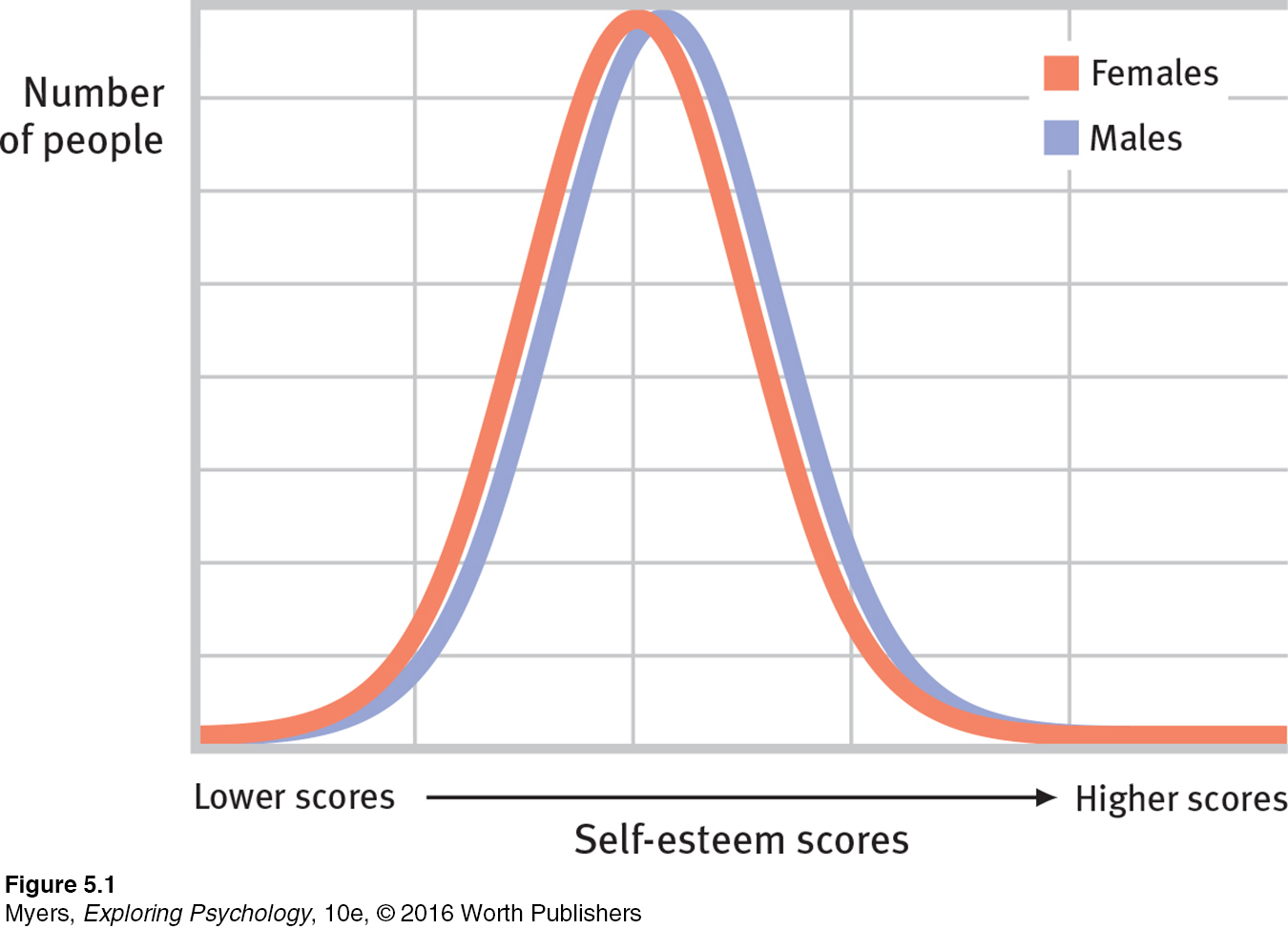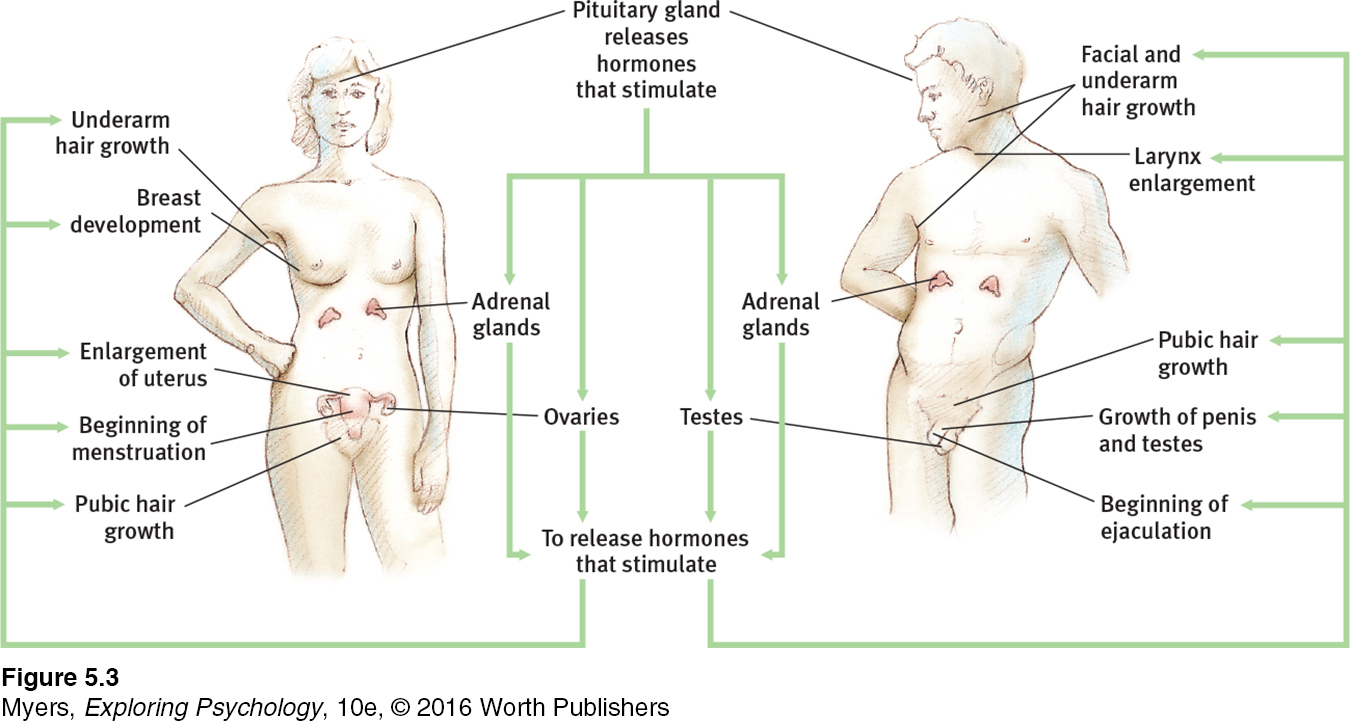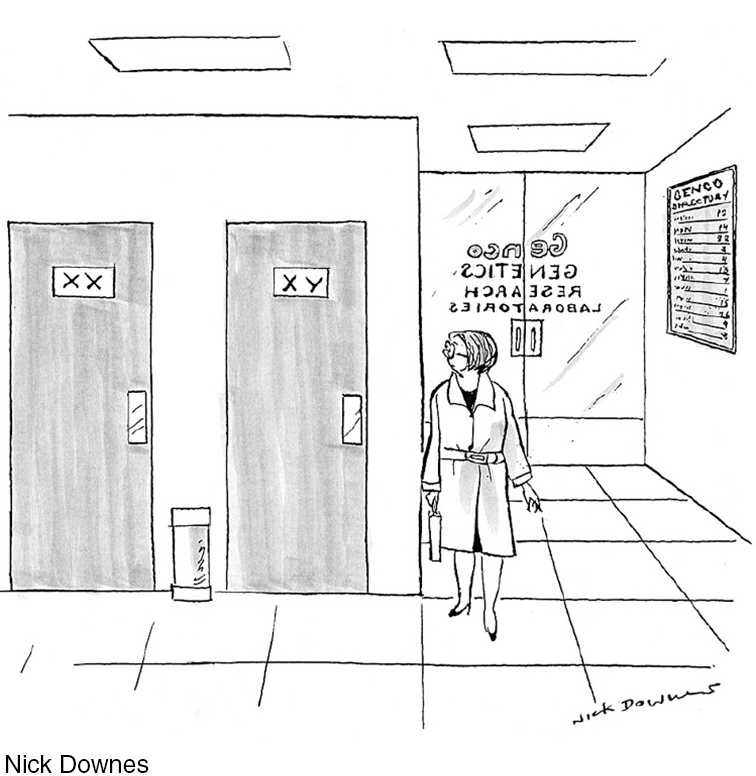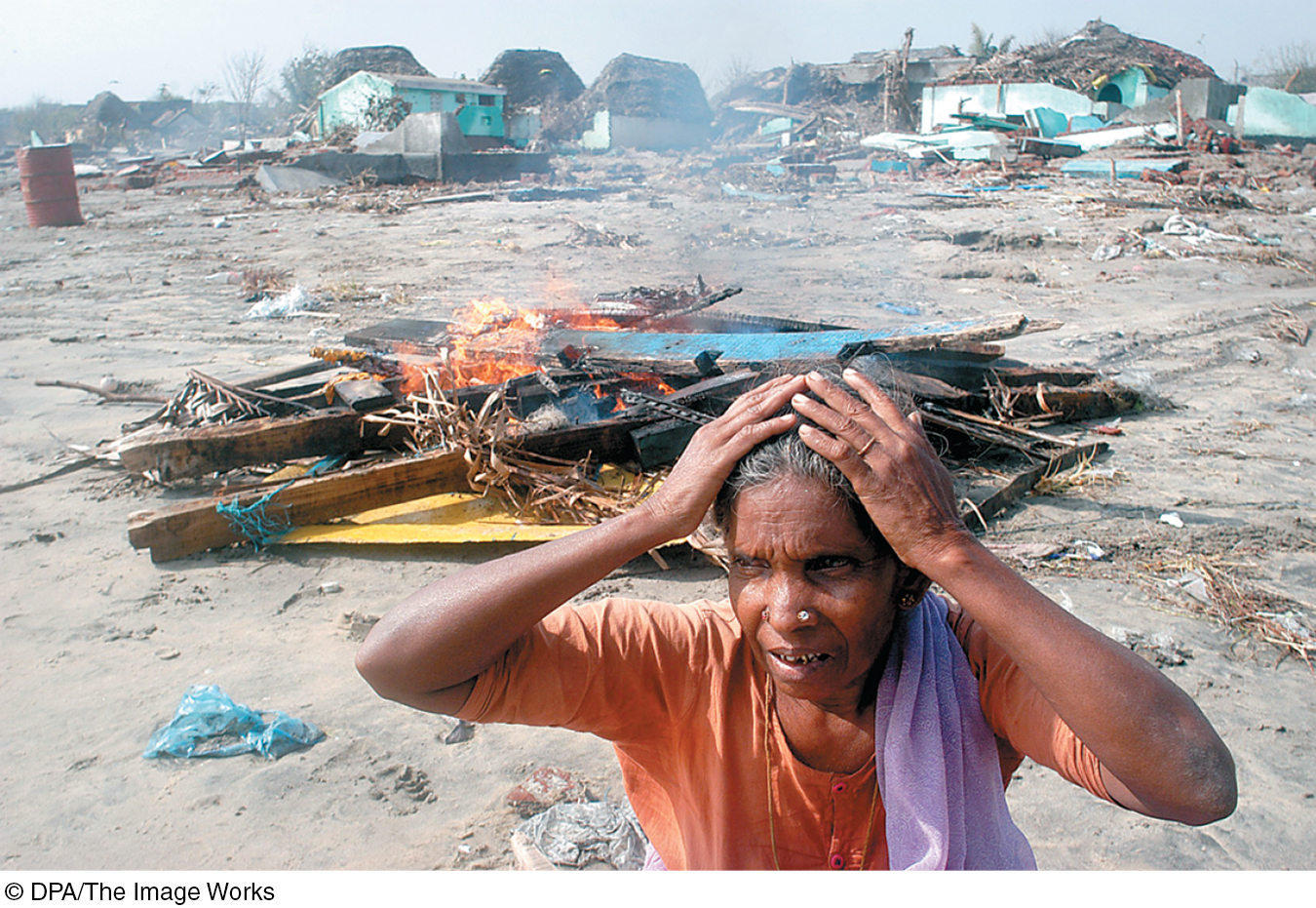5.1 Gender Development
5-
sex in psychology, the biologically influenced characteristics by which people define males and females.
gender in psychology, the socially influenced characteristics by which people define men and women.
We humans share an irresistible urge to organize our worlds into simple categories. Among the ways we classify people—
Our gender is the product of the interplay among our biological dispositions, our developmental experiences, and our current situations (Eagly & Wood, 2013). Before we consider that interplay in more detail, let’s take a closer look at some ways that males and females are both similar and different.
Pink and blue baby outfits illustrate how cultural norms vary and change. “The generally accepted rule is pink for the boy and blue for the girl,” declared the Earnshaw’s Infants’ Department in June of 1918 (Frassanito & Pettorini, 2008). “The reason is that pink being a more decided and stronger color is more suitable for the boy, while blue, which is more delicate and dainty, is prettier for the girls.”
How Are We Alike? How Do We Differ?
5-
Whether male or female, each of us receives 23 chromosomes from our mother and 23 from our father. Of those 46 chromosomes, 45 are unisex—
But in some areas, males and females do differ, and differences command attention. Some much-

Gender differences appear throughout this book, but for now let’s take a closer look at three areas—
Aggression
aggression any physical or verbal behavior intended to harm someone physically or emotionally.
To a psychologist, aggression is any physical or verbal behavior intended to hurt someone physically or emotionally. Think of some aggressive people you have heard about. Are most of them men? Men generally admit to more aggression. They also commit more extreme physical violence (Bushman & Huesmann, 2010). In romantic relationships between men and women, minor acts of physical aggression, such as slaps, are roughly equal—
Laboratory experiments have demonstrated gender differences in aggression. Men have been more willing to blast people with what they believed was intense and prolonged noise (Bushman et al., 2007). And outside the laboratory, men—

relational aggression an act of aggression (physical or verbal) intended to harm a person’s relationship or social standing.
Here’s another question: Think of examples of people harming others by passing along hurtful gossip, or by shutting someone out of a social group or situation. Were most of those people men? Perhaps not. Those behaviors are acts of relational aggression, and women are slightly more likely than men to commit them (Archer, 2004, 2007, 2009).
Social Power
Imagine you’ve walked into a job interview and are taking your first look at the two interviewers. The unsmiling person on the left oozes self-
Which interviewer is male?
If you said the person on the left, you’re not alone. Around the world, from Nigeria to New Zealand, people have perceived gender differences in power (Williams & Best, 1990). Indeed, in most societies men do place more importance on power and achievement and are socially dominant (Schwartz & Rubel-
When groups form, whether as juries or companies, leadership tends to go to males (Colarelli et al., 2006). And when salaries are paid, those in traditionally male occupations receive more.
When people run for election, women who appear hungry for political power experience less success than their equally power-
hungry male counterparts (Okimoto & Brescoll, 2010). And when elected, political leaders usually are men, who held 78 percent of the seats in the world’s governing parliaments in 2015 (IPU, 2015).
Men and women also lead differently. Men tend to be more directive, telling people what they want and how to achieve it. Women tend to be more democratic, more welcoming of others’ input in decision making (Eagly & Carli, 2007; van Engen & Willemsen, 2004). When interacting, men have been more likely to offer opinions, women to express support (Aries, 1987; Wood, 1987). In everyday behavior, men tend to act as powerful people often do: talking assertively, interrupting, initiating touches, and staring. And they smile and apologize less (Leaper & Ayres, 2007; Major et al., 1990; Schumann & Ross, 2010). Such behaviors help sustain men’s greater social power.
Women’s 2015 representation in national parliaments ranged from 13 percent in the Pacific region to 41 percent in Scandinavia (IPU, 2015).
Social Connectedness
Whether male or female, we all have a need to belong, though we may satisfy this need in different ways (Baumeister, 2010). Males tend to be independent. Even as children, males typically form large play groups. Boys’ games brim with activity and competition, with little intimate discussion (Rose & Rudolph, 2006). As adults, men enjoy doing activities side by side, and they tend to use conversation to communicate solutions (Tannen, 1990; Wright, 1989).

Females tend to be more interdependent. In childhood, girls usually play in small groups, often with one friend. They compete less and imitate social relationships more (Maccoby, 1990; Roberts, 1991). Teen girls spend more time with friends and less time alone (Wong & Csikszentmihalyi, 1991). In late adolescence, they spend more time on social networking sites (Pryor et al., 2007, 2011), and teen girls average twice as many text messages per day as boys (Lenhart, 2012). As adults, women take more pleasure in talking face to face, and they tend to use conversation more to explore relationships. Brain scans suggest that women’s brains are better wired to improve social relationships, and men’s brains to connect perception with action (Ingalhalikar et al., 2013).
A gender difference in communication style was apparent in one New Zealand study of student e-
More than a half-
In the workplace, women are less often driven by money and status, and more often opt for reduced work hours (Pinker, 2008). For many, family obligations loom large, with mothers, compared to fathers, spending twice as many hours doing child care (Parker & Wang, 2013). Both men and women have reported their friendships with women as more intimate, enjoyable, and nurturing (Kuttler et al., 1999; Rubin, 1985; Sapadin, 1988). When searching for understanding from someone who will share their worries and hurts, people usually turn to women. How do they cope with their own stress? Compared with men, women are more likely to turn to others for support. They are said to tend and befriend (Tamres et al., 2002; Taylor, 2002).
The gender gap in both social connectedness and power peaks in late adolescence and early adulthood—
So, although women and men are more alike than different, there are some behavior differences between the average woman and man. Are such differences dictated by our biology? Shaped by our cultures and other experiences? Do we vary in the extent to which we are male or female? Read on.
“In the long years liker must they grow; The man be more of woman, she of man.”
Alfred Lord Tennyson, The Princess, 1847
RETRIEVE IT
Question
________ (Men/Women) are more likely to commit relational aggression, and ________(men/women) are more likely to commit physical aggression.
Question
________(Men/Women) have tended to express more personal and professional interest in people and less interest in things.
The Nature of Gender: Our Biological Sex
5-
In many physical ways—
Biology does not dictate gender. But in two ways, biology influences gender:
Genetically—
males and females have differing sex chromosomes. Physiologically—
males and females have differing concentrations of sex hormones, which trigger other anatomical differences.
These two influences began to form you long before you were born.
Prenatal Sexual Development
X chromosome the sex chromosome found in both men and women. Females have two X chromosomes; males have one. An X chromosome from each parent produces a female child.
Y chromosome the sex chromosome found only in males. When paired with an X chromosome from the mother, it produces a male child.
Six weeks after you were conceived, you and someone of the other sex looked much the same. Then, as your genes kicked in, your biological sex—
testosterone the most important of the male sex hormones. Both males and females have it, but the additional testosterone in males stimulates the growth of the male sex organs during the fetal period, and the development of the male sex characteristics during puberty.
About seven weeks after conception, a single gene on the Y chromosome throws a master switch, which triggers the testes to develop and to produce testosterone, the principal male hormone that promotes development of male sex organs. (Females also have testosterone, but less of it.)
Later, during the fourth and fifth prenatal months, sex hormones bathe the fetal brain and influence its wiring. Different patterns for males and females develop under the influence of the male’s greater testosterone and the female’s ovarian hormones (Hines, 2004; Udry, 2000).
Adolescent Sexual Development
puberty the period of sexual maturation, when a person becomes capable of reproducing.
A flood of hormones triggers another period of dramatic physical change during adolescence, when boys and girls enter puberty. In this two-
primary sex characteristics the body structures (ovaries, testes, and external genitalia) that make sexual reproduction possible.
secondary sex characteristics nonreproductive sexual traits, such as female breasts and hips, male voice quality, and body hair.
Girls’ slightly earlier entry into puberty can at first propel them to greater height than boys of the same age (FIGURE 5.2 below). But boys catch up when they begin puberty, and by age 14, they are usually taller than girls. During these growth spurts, the primary sex characteristics—the reproductive organs and external genitalia—


spermarche [sper-
For boys, puberty’s landmark is the first ejaculation, which often occurs first during sleep (as a “wet dream”). This event, called spermarche, usually happens by about age 14.
Pubertal boys may not at first like their sparse beard. (But then it grows on them.)

menarche [meh-
 For a 7-
For a 7-
In girls, the landmark is the first menstrual period, menarche, usually within a year of age 12½ (Anderson et al., 2003). Genes play a major role in predicting when girls experience menarche (Perry et al., 2014). But environment matters, too. Early menarche is more likely following stresses related to father absence, sexual abuse, insecure attachments, or a history of a mother’s smoking during pregnancy (DelPriore & Hill, 2013; Rickard et al., 2014; Shrestha et al., 2011). In various countries, girls are developing breasts earlier (sometimes before age 10) and reaching puberty earlier than in the past. Suspected triggers include increased body fat, diets filled with hormone-
Girls prepared for menarche usually experience it positively (Chang et al., 2009). Most women recall their first menstrual period with mixed emotions—

RETRIEVE IT
Question
Prenatal sexual development begins about weeks after conception. Adolescence is marked by the onset of .
Sexual Development Variations
disorder of sexual development a condition present at birth that involves unusual development of sex chromosomes and anatomy.
Sometimes nature blurs the biological line between males and females. When a fetus is exposed to unusual levels of sex hormones, or is especially sensitive to those hormones, the individual may develop a disorder of sexual development, with chromosomes or anatomy not typically male or female. For example, a genetic male may be born with normal male hormones and testes but no penis or a very small one.
In the past, medical professionals often recommended sex-
Sex-
The bottom line: “Sex matters,” concluded the National Academy of Sciences (2001). Sex-
The Nurture of Gender: Our Culture and Experiences
5-
For many people, biological sex and gender coexist in harmony. Biology draws the outline, and culture paints the details. The physical traits that define us as biological males or females are the same worldwide. But the gender traits that define how men (or boys) and women (or girls) should act, interact, or feel about themselves may differ from one place to another (APA, 2009).
Gender Roles
role a set of expectations (norms) about a social position, defining how those in the position ought to behave.

gender role a set of expected behaviors, attitudes, and traits for males or for females.
Cultures shape our behaviors by defining how we ought to behave in a particular social position, or role. We can see this shaping power in gender roles—the social expectations that guide our behavior as men or women. Gender roles shift over time. A century ago, American women could not vote in national elections, serve in the military, or divorce a husband without cause. And if a woman worked for pay, she would more likely have been a midwife or a seamstress than a surgeon or a shopkeeper.
Gender roles can change dramatically in a thin slice of history. At the beginning of the twentieth century, only one country in the world—

Gender roles also vary from one place to another. Nomadic societies of food-
Take a minute to check your own gender expectations. Would you agree that “When jobs are scarce, men should have more rights to a job?” In the United States, Britain, and Spain, barely over 12 percent of adults agree. In Nigeria, Pakistan, and India, about 80 percent of adults agree (Pew, 2010). We’re all human, but my how our views differ. The Scandinavian countries offer the greatest gender equity, Middle Eastern and North African countries the least (World Economic Forum, 2014).
How Do We Learn Gender?
gender identity our sense of being male, female, or some combination of the two.
A gender role describes how others expect us to think, feel, and act. Our gender identity is our personal sense of being male, female, or, occasionally, some combination of the two. How do we develop that personal viewpoint?

social learning theory the theory that we learn social behavior by observing and imitating and by being rewarded or punished.
gender typing the acquisition of a traditional masculine or feminine role.
androgyny displaying both traditional masculine and feminine psychological characteristics.
Social learning theory assumes that we acquire our identity in childhood, by observing and imitating others’ gender-
How we feel matters, but so does how we think. Early in life we form schemas, or concepts that help us make sense of our world. Our gender schemas organize our experiences of male-
As a young child, you (like other children) were a “gender detective” (Martin & Ruble, 2004). Before your first birthday, you knew the difference between a male and female voice or face (Martin et al., 2002). After you turned 2, language forced you to label the world in terms of gender. If you are an English speaker, you learned to classify people as he and she. If you are a French speaker, you learned to classify objects as masculine (“le train”) or feminine (“la table”).
Once children grasp that two sorts of people exist—
transgender an umbrella term describing people whose gender identity or expression differs from that associated with their birth sex.
For a transgender person, gender identity differs from the behaviors or traits considered typical for that person’s assigned birth sex (APA, 2010; Bockting, 2014). Even as 5-

 For a 6.5-
For a 6.5-
Note that gender identity is distinct from sexual orientation (the direction of one’s sexual attraction). Transgender people may be sexually attracted to people of the other birth sex (heterosexual), the same birth sex (homosexual), both sexes (bisexual), or to no one at all (asexual).
Transgender people sometimes express their gender identity by dressing as a person of the other biological sex typically would. Most who dress this way are biological males who are attracted to women (APA, 2010).
“The more I was treated as a woman, the more woman I became.”
Writer Jan Morris, male-
RETRIEVE IT
Question
What are gender roles, and what do their variations tell us about our human capacity for learning and adaptation?
REVIEW Gender Development
Learning Objectives
Test Yourself by taking a moment to answer each of these Learning Objective Questions (repeated here from within the chapter). Research suggests that trying to answer these questions on your own will improve your long-
Question
5-
Question
5-
Question
5-
Question
5-
Terms and Concepts to Remember
Test yourself on these terms.
Question
sex (p. 172) gender (p. 172) aggression (p. 173) relational aggression (p. 173) X chromosome (p. 175) Y chromosome (p. 175) testosterone (p. 175) puberty (p. 175) primary sex characteristics (p. 175) secondary sex characteristics (p. 175) spermarche (p. 175) menarche (p. 176) disorder of sexual development (p. 177) role (p. 177) gender role (p. 177) gender identity (p. 178) social learning theory (p. 178) gender typing (p. 178) androgyny (p. 178) transgender (p. 179) | the theory that we learn social behavior by observing and imitating and by being rewarded or punished. the sex chromosome found only in males. When paired with an X chromosome from the mother, it produces a male child. the body structures (ovaries, testes, and external genitalia) that make sexual reproduction possible. our sense of being male, female, or some combination of the two. in psychology, the socially influenced characteristics by which people define men and women. nonreproductive sexual traits, such as female breasts and hips, male voice quality, and body hair. a condition present at birth that involves unusual development of sex chromosomes and anatomy. an act of aggression (physical or verbal) intended to harm a person's relationship or social standing. the sex chromosome found in both men and women. Females have two X chromosomes; males have one. An X chromosome from each parent produces a female child. the period of sexual maturation, when a person becomes capable of reproducing. the most important of the male sex hormones. Both males and females have it, but the additional testosterone in males stimulates the growth of the male sex organs during the fetal period, and the development of the male sex characteristics during puberty. an umbrella term describing people whose gender identity or expression differs from that associated with their birth sex. in psychology, the biologically influenced characteristics by which people define males and females. displaying both traditional masculine and feminine psychological characteristics. a set of expectations (norms) about a social position, defining how those in the position ought to behave. [sper- the acquisition of a traditional masculine or feminine role. [meh- a set of expected behaviors, attitudes, and traits for males or for females. any physical or verbal behavior intended to harm someone physically or emotionally. |
Experience the Testing Effect
Test yourself repeatedly throughout your studies. This will not only help you figure out what you know and don’t know; the testing itself will help you learn and remember the information more effectively thanks to the testing effect.
Question 5.1
1. Psychologists define as the biologically influenced characteristics by which people define males and females. The socially influenced characteristics by which people define men and women is .
Question 5.2
2. Females and males are very similar to each other. But one way they differ is that
| A. |
| B. |
| C. |
| D. |
Question 5.3
3. A fertilized egg will develop into a boy if it receives a/n chromosome from its father.
Question 5.4
4. Primary sex characteristics relate to ________; secondary sex characteristics refer to ________.
| A. |
| B. |
| C. |
| D. |
Question 5.5
5. On average, girls begin puberty at about the age of , boys at about the age of .
Question 5.6
6. An individual who is born with sexual anatomy that differs from typical male or female anatomy has a .
Question 5.7
7. Gender role refers to our
| A. |
| B. |
| C. |
| D. |
Question 5.8
8. When children have developed a , they have a sense of being male, female, or some combination of the two.
Use  to create your personalized study plan, which will direct you to the resources that will help you most in
to create your personalized study plan, which will direct you to the resources that will help you most in  .
.